
NGC 300 (also known as Caldwell 70 or the Sculptor Pinwheel Galaxy) is a spiral galaxy in the constellation Sculptor. It is one of the closest galaxies to the Local Group, and probably lies between the latter and the Sculptor Group. It is the brightest of the five main spirals in the direction of the Sculptor Group. It is inclined at an angle of 42° when viewed from Earth and shares many characteristics of the Triangulum Galaxy. It is 94,000 light-years in diameter, somewhat smaller than the Milky Way, and has an estimated mass of (2.9 ± 0.2) × 1010M☉.

NGC 6946, sometimes referred to as the Fireworks Galaxy, is a face-on intermediate spiral galaxy with a small bright nucleus, whose location in the sky straddles the boundary between the northern constellations of Cepheus and Cygnus. Its distance from Earth is about 25.2 million light-years or 7.72 megaparsecs, similar to the distance of M101 in the constellation Ursa Major. Both were once considered to be part of the Local Group, but are now known to be among the dozen bright spiral galaxies near the Milky Way but beyond the confines of the Local Group. NGC 6946 lies within the Virgo Supercluster.

Luminous blue variables (LBVs) are massive evolved stars that show unpredictable and sometimes dramatic variations in their spectra and brightness. They are also known as S Doradus variables after S Doradus, one of the brightest stars of the Large Magellanic Cloud. They are considered to be rare.

NGC 4725 is an intermediate barred spiral galaxy with a prominent ring structure, located in the northern constellation of Coma Berenices near the north galactic pole. It was discovered by German-born British astronomer William Herschel on April 6, 1785. The galaxy lies at a distance of approximately 40 megalight-years from the Milky Way. NGC 4725 is the brightest member of the Coma I Group of the Coma-Sculptor Cloud, although it is relatively isolated from the other members of this group. This galaxy is strongly disturbed and is interacting with neighboring spiral galaxy NGC 4747, with its spiral arms showing indications of warping. The pair have an angular separation of 24′, which corresponds to a projected linear separation of 370 kly. A tidal plume extends from NGC 4747 toward NGC 4725.

NGC 520, also known as the Flying Ghost, is a pair of colliding spiral galaxies about 105 million light-years away in the constellation Pisces. They were discovered by astronomer William Herschel on 13 December 1784.
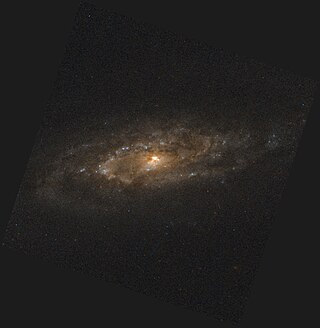
NGC 7537 is a spiral galaxy located in the equatorial constellation of Pisces, about 1.5° to the NNW of Gamma Piscium. It was first documented by German-born astronomer William Herschel on Aug 30, 1785. J. L. E. Dreyer described it as, "very faint, considerably small, round, brighter middle, southwestern of 2". This galaxy lies at a distance of approximately 127 Mly (39 Mpc) from the Milky Way, and is a member of the Pegasus I cluster.
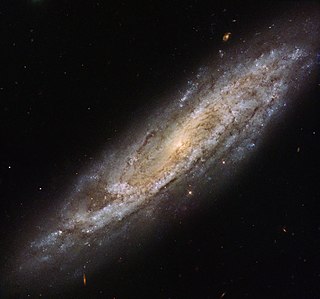
NGC 2770 is a spiral galaxy in the northern constellation of Lynx, near the northern constellation border with Cancer. It was discovered by German-born astronomer William Herschel on December 7, 1785. J. L. E. Dreyer described it as, "faint, large, much extended 150°, mottled but not resolved, 2 stars to north". NGC 2770 was the target for the first binocular image produced by the Large Binocular Telescope.
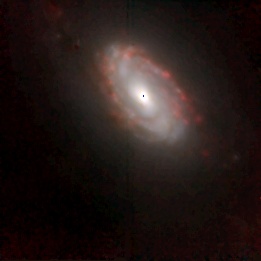
NGC 23 is a spiral galaxy located in the northern constellation of Pegasus, around 173.5 megalight-years distant from the Milky Way. It was discovered by William Herschel on 10 September 1784. In the Webb Society Deep-Sky Observer's Handbook, the visual appearance of NGC 23 is described as follows:
Bright, extended ellipse; a bright nuclear structure is noticeably elongated; two weak spiral enhancements emerge from opposite sides of the nucleus, one curving towards a bright star attached on the south end. The galaxy is likely interacting with NGC 9.
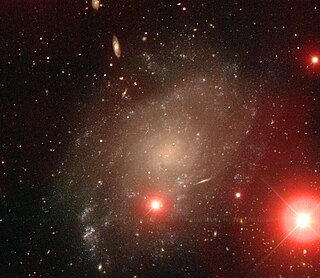
NGC 45 is a low surface brightness spiral galaxy in the equatorial constellation of Cetus. It was discovered on 11 November 1835 by the English astronomer John Herschel. The galaxy is located at a distance of 22 million light years and is receding with a heliocentric radial velocity of 466 km/s. It is located in the vicinity of the Sculptor Group, but is most likely a background galaxy.
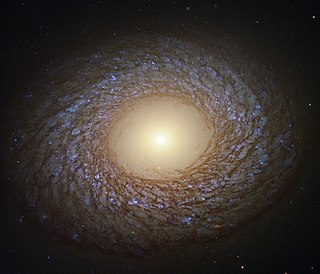
NGC 2775, also known as Caldwell 48, is a spiral galaxy in the constellation Cancer. It is 67 million light-years away from the Milky Way. It was discovered by William Herschel in 1783. NGC 2775 belongs to the Antlia-Hydra Cluster of galaxies and is the most prominent member of the NGC 2775 Group, a small galaxy group in the Virgo Super-cluster, along with the Local Group. Other members of the NGC 2775 Group include NGC 2777 and UGC 4781.

NGC 5584 is a barred spiral galaxy in the constellation Virgo. It was discovered July 27, 1881 by American astronomer E. E. Barnard. Distance determination using Cepheid variable measurements gives an estimate of 75 million light years, whereas the tip of the red-giant branch approach yields a distance of 73.4 million light years. It is receding with a heliocentric radial velocity of 1,637 km/s. It is a member of the Virgo III Groups, a series of galaxies and galaxy clusters strung out to the east of the Virgo Supercluster of galaxies.
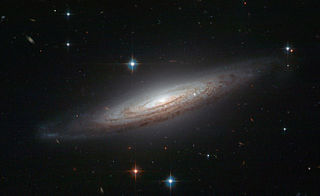
NGC 634 is a spiral galaxy, lying at a distance of 217.1 megalight-years away from the Milky Way in the northern constellation of Triangulum. This object was discovered in the nineteenth century by French astronomer Édouard Stephan. It is inclined by an angle of 82.4° to the line of sight from the Earth, and thus is being viewed nearly edge on.

NGC 2748 is a spiral galaxy in the northern circumpolar constellation of Camelopardalis, located at a distance of 61.3 megalight-years from the Milky Way. It was discovered September 2, 1828 by John Herschel. The morphological classification of SAbc indicates this is an unbarred spiral with moderate to loosely-wound spiral arms. It is a disk-like peculiar galaxy with a stellar shell that is rotating about the main galactic axis. This shell was most likely formed through the capture and disruption of a dwarf companion. The galactic nucleus likely contains a supermassive black hole with a mass of 4.4+3.5
−3.6×107 M☉, or 44 million times the mass of the Sun.
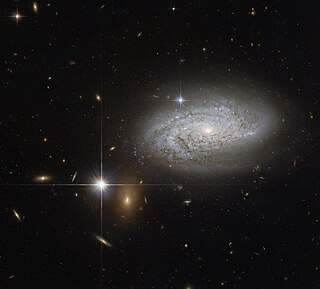
NGC 3021 is a spiral galaxy in the northern constellation of Leo Minor. It is about 93 million light-years away from Earth, and is receding with a heliocentric radial velocity of 1,537±4 km/s. This galaxy was discovered December 7, 1785 by Anglo-German astronomer William Herschel. The morphological classification of NGC 3021 is SA(rs)bc, which indicates a spiral galaxy with no central bar (SA), an incomplete inner ring structure (rs), and moderate to loosely wound spiral arms (bc).
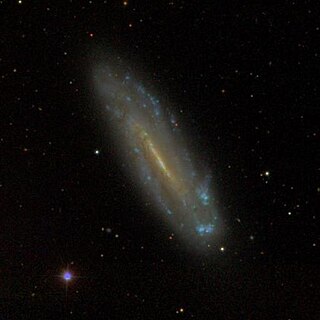
NGC 4178 is the New General Catalogue identifier for a barred spiral galaxy in the equatorial constellation of Virgo. It was discovered April 11, 1825 by English astronomer John Herschel. Located some 43.8 million light years away, this galaxy spans 2.3 × 0.4 arc minutes and is seen at a low angle, being inclined by 77° to the line of sight from the Earth. The morphological classification of NGC 4178 is SB(rs)dm, indicating that it has a bar feature at the core, and, per the '(rs)', has traces of a ring-like structure surrounding the bar. The 'dm' suffix indicates the spiral arms are diffuse, broken, and irregular in appearance with no bulge at the nucleus. This galaxy is a member of the Virgo Cluster, which is the richest nearby group of galaxies outside the Local Group and forms the core of the Virgo Supercluster.

NGC 6753 is a massive unbarred spiral galaxy, seen almost exactly face-on, in the southern constellation of Pavo. It was discovered by the English astronomer John Herschel on July 5, 1836. The galaxy is located at a distance of 142 million light years from the Milky Way, and is receding with a heliocentric radial velocity of 3,140 km/s. It does not display any indications of a recent interaction with another galaxy or cluster.

NGC 3294 is a spiral galaxy in the constellation Leo Minor. It was discovered by William Herschel on Mar 17, 1787. It is a member of the Leo II Groups, a series of galaxies and galaxy clusters strung out from the right edge of the Virgo Supercluster. The galaxy is located at a distance of 98 million light years and is receding with a heliocentric radial velocity of 1,586 km/s. The morphological class of NGC 3294 is SA(rs)bc, which means this is a spiral galaxy with no central bar (SA), an incomplete inner ring structure (rs), and moderately wound spiral arms (bc).

NGC 1325 is a flocculent spiral galaxy situated in the constellation of Eridanus. Located about 75 million light years away, it is a member of the Eridanus cluster of galaxies, a cluster of about 200 galaxies. It was discovered by William Herschel on 19 December 1799.

NGC 3786 is an intermediate spiral galaxy located 107.5 million light-years away in the northern constellation of Ursa Major. It was discovered by English astronomer John Herschel on April 10, 1831. This object appears to form a close pair with its peculiar neighbor to the north, NGC 3788. They show some indications of interaction, such as minor distortion of the disk or tidal features.

NGC 7421 is a barred spiral galaxy in the southern constellation of Grus. It was discovered by English astronomer John Herschel on August 30, 1834. In Danish astronomer J. L. E. Dreyer's New General Catalogue of Nebulae and Clusters of Stars it was described as: considerably bright, large, very little extended, gradually pretty much brighter middle, and partially resolved. NGC 7421 is located at an estimated distance of 81.6 million light-years (25.01 Mpc) from the Sun. It is a member of the IC 1459 galaxy group.





















